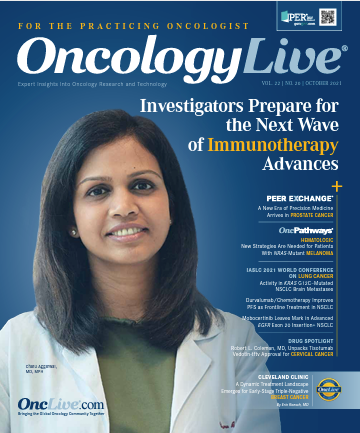Publication
Article
Investigators Prepare for the Next Wave of Immunotherapy Advances
Author(s):
Since Charu Aggarwal, MD, MPH, helped conduct the first phase 1 trial of pembrolizumab nearly a decade ago, she has been recognized as a pioneer in testing immunotherapy treatments for thoracic cancers.
Charu Aggarwal, MD, MPH

Since Charu Aggarwal, MD, MPH, helped conduct the first phase 1 trial of pembrolizumab (Keytruda) nearly a decade ago, she has been recognized as a pioneer in testing immunotherapy treatments for thoracic cancers. From this launchpad, her research focuses broadened to include liquid biopsies, expanding the knowledge bank of personalized care for patients.
Aggarwal is the Leslye M. Heisler Associate Professor for Lung Cancer Excellence at the University of Pennsylvania (UPenn) Perelman School of Medicine in Philadelphia. In her work at UPenn, Aggarwal conducts research in a variety of areas, particularly the development and validation of liquid biopsies designed not only for initial diagnosis, but also for the repeated evaluation of a treatment’s initial and ongoing efficacy.
“Dr Aggarwal has conducted some of the pioneering work in liquid biopsy research, work Howard “Jack” West, MD that has changed how we use liquid biopsies and increased our confidence in it as a routine tool,” Howard “Jack” West, MD, clinical executive director of AccessHope and associate clinical professor in the Department of Medical Oncology & Therapeutics Research at City of Hope in Duarte, California, said.
Howard “Jack” West, MD

“She has also helped conduct and oversee some of the important retrospective database work that has shaped our ideas of optimal care for patients with KRAS mutations, determining whether they should receive immunotherapy alone or immunotherapy with chemotherapy,” said West, who has worked with Aggarwal for many years and hosts a podcast with her.
Benjamin Levy, MD, associate professor at Johns Hopkins University School of Medicine and clinical director of medical oncology at Johns Hopkins Sidney Kimmel Cancer Center at Sibley Memorial Hospital in Baltimore, Maryland, echoed West’s praise for Aggarwal’s work in liquid biopsies.
Benjamin Levy, MD

“She has done some of the seminal work with liquid biopsies in advanced lung cancer,” he said. “Through her research, she has demonstrated that circulating tumor DNA [ctDNA] can be a very powerful tool in not only genotyping lung cancer patients, but also serving as a real-time surrogate or response in patients treated with targeted therapy and immunotherapy via longitudinal assessments with this platform.”
Levy described Aggarwal as incredibly persistent. “She doesn’t stop until the research question is answered,” he said. “When you combine that dedication with intelligence [and] ability to think out of the box and investigate ideas that others haven’t considered, you have a very successful researcher.”
Aggarwal is cochair of the 6th Annual International Congress on Immunotherapies in Cancer®, which will take place as a hybrid, interactive event on Saturday, December 11 at the InterContinental New York Times Square.
The 1-day conference, hosted by Physicians’ Education Resource®, LLC (PER®), will provide a comprehensive review of clinical trial–derived and real-world data that are most relevant to the application of cancer immunotherapy. Topics of particular attention will be new developments in biomarkers, recent immunotherapy combinations, and strategies for mitigating adverse events (AEs).
Aggarwal and conference cochair Mario Sznol, MD—who leads the melanoma program and coleads the cancer immunotherapy program at Yale Cancer Center, in New Haven, Connecticut—have assembled a team of experts to discuss recent findings in a host of subjects:
- Stratifying risk and predicting response to immunotherapeutic regimens in cancer management
- Correlating each immunotherapy’s mechanisms of action to its application in the treatment of malignancy
- Evaluating emerging data from clinical trials on the efficacy and safety of cancer immunotherapy regimens
- Implementing practical strategies for the immunotherapy management of solid and hematologic malignancies, along with the management of AEs
“There has been this wave of approvals in the past few years, starting with melanoma and lung cancer and moving to other tumor types,” Aggarwal said in an interview with OncologyLive®. “At the same time, we are seeing approved uses for immunotherapy move from the metastatic setting to the neoadjuvant and adjuvant settings in diseases such as kidney cancer, lung cancer, and more. What I want the attendees to take out of this conference is practical information on how to apply chemotherapy or immunotherapy in the clinic, in the context of new clinical information and new clinical trials that have been presented at recent meetings.”
Personalizing Approaches to Treatment
Although neither of her parents were doctors, Aggarwal decided that she would make medicine her life’s work when she was 5 years old. The decision to specialize in cancer research was made when she was pursuing her master’s degree and had the opportunity to work on bone marrow transplants. Aggarwal’s principal research interests are strategies for improving decisions that will tailor treatments for each individual patient with cancer.
For example, she was recently the senior author of an analysis of the association of KRAS variant status and outcomes in patients who received immunotherapy alone vs those who received immunotherapy plus chemotherapy.1 The study compared outcomes among 1127 patients with advanced nonsquamous non–small cell lung cancer (NSCLC) with PD-L1 expression of 50% or greater, 573 of whom (50.8%) had KRAS-mutant disease and 554 of whom (49.2%) had KRAS wild-type disease. Among patients with KRAS-mutant disease, overall survival (OS) did not differ between those treated with immune checkpoint inhibitor (ICI) monotherapy and chemoimmunotherapy; the median OS was 21.1 vs 20.0 months, respectively (adjusted HR, 1.03; 95% CI, 0.75-1.40; P = .78). Among patients with KRAS wild-type disease, those treated with ICI monotherapy had worse survival vs those treated with chemoimmunotherapy, although the difference was not statistically significant (median OS, 13.6 vs 19.3 months, respectively; adjusted HR, 1.19; 95% CI, 0.89-1.58; P = .06).
Aggarwal and her colleagues wrote that the results of the analysis suggest that patients with KRAS wild-type disease should get the combination of immunotherapy and chemotherapy, but the absence of any apparent survival benefit of adding chemotherapy to immunotherapy for patients with KRAS-mutant disease struck Aggarwal as an equally important finding.
“In my mind, the question is not who should get chemotherapy, but rather, who can avoid chemotherapy,” Aggarwal said. “With the explosion of immunotherapy, we can now deliver [agents] safely with a survival benefit for most of our patients. There will always be a subset [of patients who] cannot get immunotherapy, but for the vast majority of our patients, they can, and we can use testing to determine which patients can get immunotherapy alone. It’s only for a small subset of patients that we’re now using a combination of chemotherapy and immunotherapy.”
The molecular phenotyping needed to guide the cancer treatment by driver or resistance mutations has relied mostly on formalin-fixed, paraffin-embedded specimens from tissue biopsies. Investigative efforts from Aggarwal and others have demonstrated that materials shed by tumors that then reside in bodily fluids including urine, saliva, pleural effusion, cerebrospinal fluid, and especially blood, can provide much of the same information.2
Tumor analytes in blood include tumor- derived extracellular vesicles, circulating tumor cells, messenger RNA, microRNA, and ctDNA, which is contained in plasma cell-free DNA (cfDNA).
Several plasma cfDNA genotyping assays for NSCLC have been approved by the FDA for clinical practice, including assays based on polymerase chain reaction and next- generation sequencing (NGS).3 Available assays include the following (Table4-6):
- Cobas EGFR Mutation Test, which was approved for the identification of EGFR driver mutations that may benefit from treatment with tyrosine kinase inhibitors (TKIs);
- Guardant360 CDx, which can detect mutations in EGFR, ALK, ROS1, BRAF, RET, MET, NTRK, KRAS, and ERBB2 (HER2) and is approved as a companion diagnostic for 3 agents in NSCLC; and
- FoundationOne Liquid CDx, which was approved in 2020 to detect more than 300 cancer-related genes and multiple genomic signatures such as tumor mutational burden and microsatellite instability.
Table. Approved Plasma Companion Diagnostics for NSCLC4-6

Investigators have compared genotyping results acquired by tissue and plasma assays and found a high level of concordance. For example, Aggarwal and coinvestigators at the UPenn, collected 112 plasma samples from 102 prospectively enrolled patients with advanced NSCLC and performed NGS of 70 genes. They then compared results with those obtained from tissue samples in 50 of the patients. Actionable EGFR mutations were detected in 24 tissue and 19 ctDNA samples, yielding concordance of 79%, with a shorter time interval between tissue and blood collection associated with increased concordance (P = .038).6 In another study designed to validate plasma-based cancer genotyping, orthogonal plasma- and tissue-based clinical genotyping across more than 750 patients demonstrated high accuracy and specificity. Positive percent agreement and negative percent agreement were greater than 99% and positive predictive values were 92% to 100%.7
“There are still significant limitations. We can never characterize the cell type or the architecture of a tumor with a liquid biopsy, which is still very necessary, so looking at tissue is extremely important,” Aggarwal said. “But I think plasma or liquid biopsies are going to be essential to give us information about the rest of the tumor. In fact, it sometimes gives us a clearer picture of the heterogeneous nature of the tumor, since we can get a sense of the cells that may have more of a metastatic potential and may have slightly different mutational profile. And we can actually gather that much better than we can do with a single, small biopsy.”
A Promising Future for Liquid Biopsy
Liquid biopsies have other key advantages: They are cheaper, less painful for the patient, and take less time to analyze. Thus, they may be performed repeatedly and, in some cases, be used to determine both initial response to a treatment and when resistance begins to develop. For example, patients treated with TKIs for EGFR-mutated or ALK-rearranged NSCLCs can develop resistance mutations, which can appear in blood samples and obviate the need for repeated tissue biopsies.8
Conversely, ctDNA testing can also detect when patients with cancer are responding to immunotherapy. A 2020 study analyzed pretreatment (n = 978) and on-treatment (n = 171) ctDNA samples from 16 advanced-stage tumor types from 3 phase 1/2 trials of durvalumab (Imfinzi), with or without the anti–CTLA-4 therapy, tremelimumab. Among patients on treatment, reductions in variant allele frequencies (VAF) and lower on-treatment VAF were independently associated with longer progression-free survival (PFS) and OS as well as a higher objective response rate.9
Another potential use for liquid biopsies is early cancer detection, but tests developed to date are not sensitive enough to support such usage in NSCLC, according to current treatment guidelines.10 For a variety of reasons, the use of liquid biopsies has advanced further in the diagnosis and treatment of lung cancer than it has in many other tissue types.
“Lung cancer is really one of the leading subtypes of cancer where liquid biopsies are being used,” Aggarwal said. “That’s largely because there is a significant amount of ctDNA shed into the bloodstream in patients with advanced disease and also because lung cancer has so many different subtypes that now have actionable mutations that are targeted by particular drugs, where we can actually immediately act and say, ‘You have an EGFR mutation. I’m going to give you a pill that targets that’ or, ‘You have a MET exon 14 mutation, so I’m going to give you something that targets that.’ There’s just more actionality to lung cancer than there is to other diseases. But having said that, you know, breast cancer, [gastrointestinal] cancer, and [genitourinary] cancer are all now rapidly taking up these liquid biopsy tools and expanding the liquid biopsy space to really utilize it in the clinical setting.”
Managing Immune-Related Adverse Events
Another major topic of conversation at the International Congress on Immunotherapies in Cancer® will be AEs associated with immunotherapy. Panelists will, of course, discuss evolving strategies for managing AEs—strategies that have significantly reduced the dangers that patients face from such treatments—and the evolving guidelines from the National Comprehensive Cancer Network, the Society for Immunotherapy of Cancer, and the American Society of Clinical Oncology. Panelists will also discuss the growing evidence that suggests some AEs have a positive effect: predicting response to immunotherapy.
“There is recent evidence suggesting that the presence of immune-related AEs [irAEs] in patients that receive immunotherapy may be related to better outcomes,” Aggarwal said. “It seems that this effect may depend on the grade of AE, although the research remains preliminary, but at least what we have now suggests that grade 2 and 3 AEs may actually be better in terms of predicting an improved outcome to immunotherapy, which I think is very interesting. It’s sort of reminiscent of the old days when we used to look at things like a rash from an EGFR inhibitor that would tell us that the drug is working.”
Indeed, some studies have found a strong connection between irAEs and response to immunotherapy. For example, a 2019 study by investigators from Madrid reported on 106 patients with various tumor types treated with either pembrolizumab or nivolumab (Opdivo) monotherapy. Of the 40 patients with irAEs, 33 (82.5%) experienced an objective response. Among the 66 cases without irAEs, 11 (16.6%) had an objective response (OR, 23.5; P < .000001). The median PFS was 10 months for patients with irAEs and 3 months for those without irAEs (HR, 2.2; P = .016); median OS was 32 months for patients with irAEs and 22 months for those without irAEs, but that difference was not statistically significant.11
Getting Back Out There
Virtual conferences, no matter how well done, do not offer the same opportunity for personal connections or the sorts of one-on-one conversations that have long ranked among the most valuable aspect of conferences. The in-person conference also offers another opportunity that Aggarwal cherishes: the opportunity to travel.
“Traveling is my ultimate hobby, although it has been almost entirely suspended by the COVID-19 pandemic, and I’m greatly looking forward to getting back to it,” Aggarwal said. “I love travel for its own sake and because it ties in with one of my other major hobbies, which is photography. It has been hard to go so long without really going anywhere. Fortunately, I have had even more time to pursue my other 2 hobbies—cooking and riding my Peloton—during the pandemic.”
Although Aggarwal believes that most people who spent the last 15 months attending virtual conferences have developed severe cases of Zoom fatigue and long for a return to traditional face-to-face communication, she also believes that virtual conferences have some significant advantages and that, going forward, conferences will adopt a hybrid model that offers the best of both worlds.
“For one thing, virtual conferences increase the reach that a conference has. [Faculty] can engage [with] audiences from different time zones and different countries [making nearly] any conference a global event,” Aggarwal said. “Everyone wants to welcome our live conferences back, and I think that as the Delta variant decreases, many of us will feel comfortable interacting in a live setting again, but I would say that virtual presence has advantages and will remain an option, to some degree.”
References
- Sun L, Hsu M, Cohen RB, Langer CJ, Mamtani R, Aggarwal C. Association between KRAS variant status and outcomes with f irst-line immune checkpoint inhibitor-based therapy in patients with advanced non-small-cell lung cancer. JAMA Oncol. 2021;7(6):937-939. Published correction appears in JAMA Oncol. 2021;7(7):1074.
- Gray J, Thompson JC, Carpenter EL, Elkhouly E, Aggarwal C. Plasma cell-free DNA genotyping: from an emerging concept to a standard-of-care tool in metastatic non-small cell lung cancer. Oncologist. Published online July 3, 2021. doi:10.1002/onco.13889
- List of Cleared or Approved Companion Diagnostic Devices (In Vitro and Imaging Tools). FDA. Updated September 2, 2021. Accessed September 23, 2021. https://www.fda.gov/medical-devices/in-vitro-diagnostics/list-cleared-or-approved-companion-diagnostic-devices-in-vitro-and-imaging-tools
- Guardant360 CDx. Prescribing information. Guardant Health Inc; 2021. Accessed September 24, 2021. https://www.accessdata.fda.gov/cdrh_docs/pdf20/ P200010S002C.pdf
- FoundationOne Liquid CDx. Prescribing information. Foundation Medicine Inc; 2021. Accessed September 24, 2021. https://www.accessdata.fda.gov/cdrh_docs/pdf19/ P190032S001C.pdf
- Thompson JC, Yee SS, Troxel AB, et al. Detection of therapeutically targetable driver and resistance mutations in lung cancer patients by next-generation sequencing of cell-free circulating tumor DNA. Clin Cancer Res. 2016;22(23):57725782. doi:10.1158/1078-0432.CCR-16-1231
- Odegaard JI, Vincent JJ, Mortimer S, et al. Validation of a plasma-based comprehensive cancer genotyping assay utilizing orthogonal tissue- and plasma-based methodologies. Clin Cancer Res. 2018;24(15):3539-3549. doi:10.1158/10780432.CCR-17-3831
- Rolfo C, Mack PC, Scagliotti GV, et al. Liquid biopsy for advanced non-small cell lung cancer (NSCLC): a statement paper from the IASLC. J Thorac Oncol. 2018;13(9):1248-1268. doi:10.1016/j.jtho.2018.05.030
- Zhang Q, Luo J, Wu S, et al. Prognostic and predictive impact of circulating tumor DNA in patients with advanced cancers treated with immune checkpoint blockade. Cancer Discov. 2020;10(12):1842-1853. doi:10.1158/2159-8290. CD-20-0047
- NCCN. Clinical Practice Guidelines in Oncology. Non-small cell lung cancer, version 2.2021. Accessed September 23, 2021. https://www.nccn.org/professionals/physician_ gls/pdf/nscl.pdf
- Rogado J, Sánchez-Torres JM, Romero-Laorden N, et al. Immune-related adverse events predict the therapeutic efficacy of anti-PD-1 antibodies in cancer patients. Eur J Cancer. 2019;109:21-27. doi:10.1016/j.ejca.2018.10.014









